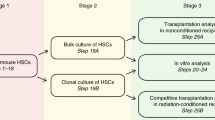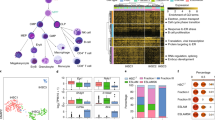Abstract
The detection of primitive hematopoietic cells based on repopulation of immune-deficient mice is a powerful tool to characterize the human stem-cell compartment. Here, we identify a newly discovered human repopulating cell, distinct from previously identified repopulating cells, that initiates multilineage hematopoiesis in NOD/SCID mice. We call such cells CD34neg- S CID r epopulating c ells, or CD34neg-SRC. CD34neg-SRC are restricted to a Lin–CD34–CD38– population without detectable surface markers for multiple lineages and CD38 or those previously associated with stem cells (HLA-DR, Thy-1 and CD34). In contrast to CD34+ subfractions, Lin–CD34–CD38– cells have low clonogenicity in short-and long-term in vitro assays. The number of CD34neg-SRC increased in short-term suspension cultures in conditions that did not maintain SRC derived from CD34+ populations, providing independent biological evidence of their distinctiveness. The identification of this newly discovered cell demonstrates complexity of the organization of the human stem-cell compartment and has important implications for clinical applications involving stem-cell transplantation.
This is a preview of subscription content, access via your institution
Access options
Subscribe to this journal
Receive 12 print issues and online access
$209.00 per year
only $17.42 per issue
Buy this article
- Purchase on Springer Link
- Instant access to full article PDF
Prices may be subject to local taxes which are calculated during checkout





Similar content being viewed by others
References
Phillips, R. Hematopoietic stem cells: concepts, assays, and controversies. Sem. Immunol. 3, 337–347 (1991).
Morrison, S., Uchida, N. & Weissman, I. The biology of hematopoietic stem cells. Annu. Rev. Cell Dev. Biol. 11, 35– 71 (1995).
Orlic, D. & Bodine, D. What defines a pluripotent hematopoietic stem cell (PHSC): will the real PHSC please stand up. Blood 84, 3991–3994 (1994).
Krause, D.S., Fackler, M.J., Civin, C.I. & May, W.S. CD34: structure, biology, and clinical utility. Blood 87, 1–13 (1996).
Andrews, R., Singer, J. & Bernstein, I. Precursors of colony-forming cells in humans can be distinguished from colony-forming cells by expression of CD33 and CD34 antigen and light scatter. J. Exp. Med. 169, 1721 (1989).
Jones, R.J. et al. Characterization of mouse lymphohematopoietic stem cells lacking spleen colony-forming activity. Blood 88, 487–491 (1996).
Goodell, M.A., Brose, K., Paradis, G., Conner, A.S. & Mulligan, R.C. Isolation and functional properties of murine hematopoietic stem cells that are replicating in vivo. J. Exp. Med. 183, 1797–1806 (1996).
Osawa, M., Hanada, K., Hamada, H. & Nakauchi, H. Long-term lymphohematopoietic reconstitution by a single CD34-low/negative hematopoietic stem cell. Science 273, 242–245 ( 1996).
Goodell, M. et al. Dye efflux studies suggest that hematopoietic stem cells expressing low or undetectable levels of CD34 antigen exist in multiple species. Nature Med. 3, 1337–1345 (1997).
Dick, J.E. Normal and leukemic human stem cells assayed in SCID mice. Sem. Immunol. 8, 197–206 ( 1996).
Lapidot, T. et al. Cytokine stimulation of multilineage hematopoiesis from immature human cells engrafted in scid mice. Science 255, 1137–1141 (1992).
Kamel-Reid, S. & Dick, J.E. Engraftment of immune-deficient mice with human hematopoietic stem cells. Science 242, 1706–1709 ( 1988).
Larochelle, A. et al. Identification of primitive human hematopoietic cells capable of repopulating NOD/SCID mouse bone marrow: implications for gene therapy. Nature Med. 2, 1329–1337 (1996).
Bhatia, M., Wang, J.C.Y., Kapp, U., Bonnet, D. & Dick, J.E. Purification of primitive human hematopoietic cells capable of repopulating immune-deficient mice. Proc. Natl. Acad. Sci. USA 94, 5320–5325 ( 1997).
Wang, J.C., Doedens, M. & Dick, J.E. Primitive human hematopoietic cells are enriched in cord blood compared with adult bone marrow or mobilized peripheral blood as measured by the quantitative in vivo SCID-repopulating cell assay. Blood 89, 3919–3924 ( 1997).
Bhatia, M. et al. Quantitative analysis reveals expansion of human hematopoietic repopulating cells after short-term ex vivo culture. J. Exp. Med. 186, 619–624 ( 1997).
Sutherland, D.R., Anderson, L., Keeney, M., Nayar, R. & Chin-Yee, I. The ISHAGE guidelines for CD34+ cell determination by flow cytometry. International Society of Hematotherapy and Graft Engineering. J. Hematother 5, 213–226 (1996).
Terstappen, L.W.W.M., Huang, S., Safford, M., Lansdorp, P.M. & Loken, M.R. Sequential generations of hematopoietic colonies derived from single nonlineage-committed CD34+CD38- progenitor cells. Blood 77, 1218–1227 ( 1991).
Huang, S. & Terstappen, L.W. Lymphoid and myeloid differentiation of single human CD34+, HLA-DR+, CD38- hematopoietic stem cells. Blood 83, 1515–1526 ( 1994).
Baum, C.M., Weissman, I.L., Tsukamoto, A.S., Buckle, A.-S. & Peault, B. Isolation of a candidate human hematopoietic stem-cell population. Proc. Natl. Acad. Sci. U.S.A. 89, 2804–2808 (1992).
Craig, W., Kay, R., Cutler, R.B. & Lansdorp, P.M. Expression of Thy-1 on human hematopoietic progenitor cells. J. Exp. Med. 177, 1331–1342 ( 1993).
Lansdorp, P.M., Dragowska, W. & Mayani, H. Ontogeny-related changes in proliferative potential of human hematopoietic cells. J. Exp. Med. 178, 787–791 (1993).
Tavian, M. et al. Aorta-associated CD34+ hematopoietic cells in the early human embryo. Blood 87, 67–72 (1996).
To, L.B., Haylock, D.N., Simmons, P.J. & Juttner, C.A. The biology and clinical uses of blood stem cells. Blood 89, 2233–2258 (1997).
Bodine, D.M., Seidel, N.E. & Orlic, D. Bone marrow collected 14 days after in vivo administration of granulocyte colony-stimulating factor and stem cell factor to mice has 10-fold more repopulating ability than untreated bone marrow. Blood 88, 89–97 ( 1996).
Hao, Q.L., Shah, A.J., Thiemann, F.T., Smogorzewska, E.M. & Crooks, G.M. A functional comparison of CD34 + CD38- cells in cord blood and bone marrow. Blood 86, 3745–3753 (1995).
Pflumio, F. et al. Phenotype and function of human hematopoietic cells engrafting immune-deficient CB17-severe combined immunodeficiency mice and nonobese diabetic-severe combined immunodeficiency mice after transplantation of human cord blood mononuclear cells. Blood 88, 3731–3740 (1996).
Hogan, C.J. et al. Engraftment and development of human CD34(+)-enriched cells from umbilical cord blood in NOD/LtSz-scid/scid mice. Blood 90, 85–96 (1997).
Grosset, C. et al. In vitro biosynthesis of leukemia inhibitory factor/human interleukin for DA cells by human endothelial cells: differential regulation by interleukin-1 alpha and glucocorticoids. Blood 86 , 3763–3770 (1995).
Korpelainen, E.I. et al. Interferon-gamma upregulates interleukin-3 (IL-3) receptor expression in human endothelial cells and synergizes with IL-3 in stimulating major histocompatibility complex class II expression and cytokine production. Blood 86, 176–182 (1995).
Zanjani, E.D., Almeida-Porada, G., Livingston, A.G., Flake, A.W. & Ogawa, M. Human bone marrow CD34- cells engraft in vivo and undergo multilineage expression that includes giving rise to CD34+ cells. Exp Hematol 26, 353– 360 (1998).
Lapidot, T. et al. A cell initiating human acute myeloid leukaemia after transplantation into SCID mice. Nature 367, 645– 648 (1994).
Bonnet, D. & Dick, J.E. Human acute myeloid leukemia is organized as a hierarchy that originates from a primitive hematopoietic cell. Nature Med. 3, 730–737 ( 1997).
Bensinger, W. et al. Transplantation of allogeneic CD34+ peripheral blood stem cells in patients with advanced hematologic malignancy. Blood 88, 4132–4138 (1997).
Croisille, L. et al. Hydrocortisone differentially affects the ability of murine stromal cells and human marrow-derived adherent cells to promote the differentiation of CD34++/CD38- long-term culture-initiating cells. Blood 84, 4116–4124 (1994).
Louache, F., Debili, N., Marandin, A., Coulombel, L. & Vainchenker, W. Expression of CD4 by human hematopoietic progenitors. Blood 84, 3344–3355 (1994).
Acknowledgements
We thank L. McWhirter for providing cord blood and fetal specimens, H. Messner and N. Jamal for providing bone marrow and peripheral blood samples, G. Knowles for technical support in the flow cytometric analysis, and R. Phillips, A. Bernstein, N. Iscove, R. McInnes and members of the laboratory for reviewing the manuscript. This work was supported by grants to J.E.D. from the Medical Research Council of Canada (MRC), the National Cancer Institute of Canada (NCIC) with funds from the Canadian Cancer Society, the Canadian Genetic Diseases Network of the National Centers of Excellence, an MRC Scientist award (J.E.D.), postdoctoral fellowships from the NCIC (M.B.), and the Human Frontier Science Organization Program (D.B.).
Author information
Authors and Affiliations
Corresponding author
Rights and permissions
About this article
Cite this article
Bhatia, M., Bonnet, D., Murdoch, B. et al. A newly discovered class of human hematopoietic cells with SCID-repopulating activity. Nat Med 4, 1038–1045 (1998). https://doi.org/10.1038/2023
Received:
Accepted:
Issue Date:
DOI: https://doi.org/10.1038/2023
This article is cited by
-
Are haematopoietic stem cell transplants stem cell transplants, is there a threshold dose of CD34-positive cells and how many are needed for rapid posttransplant granulocyte recovery?
Leukemia (2023)
-
Single cell analyses identify a highly regenerative and homogenous human CD34+ hematopoietic stem cell population
Nature Communications (2022)
-
ASXL1/EZH2 mutations promote clonal expansion of neoplastic HSC and impair erythropoiesis in PMF
Leukemia (2019)
-
Human Hematopoietic Stem Cells: Concepts and Perspectives on the Biology and Use of Fresh Versus In Vitro–Generated Cells for Therapeutic Applications
Current Stem Cell Reports (2019)
-
A revised road map for the commitment of human cord blood CD34-negative hematopoietic stem cells
Nature Communications (2018)



